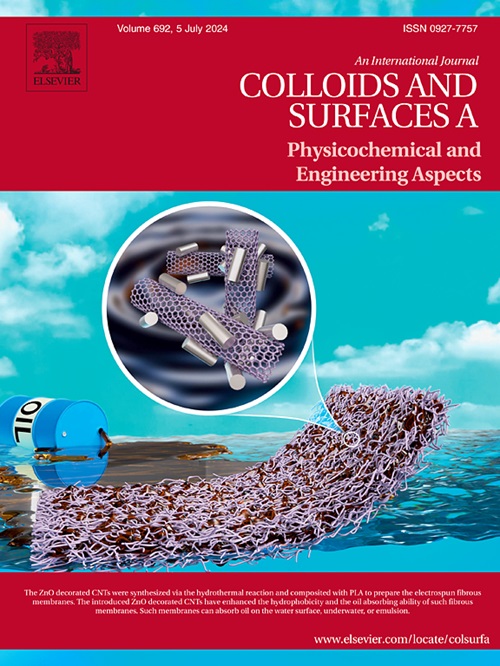MnO-N/C催化剂的转向支持促进了过氧单硫酸盐活化过程中非自由基的生成
IF 5.4
2区 化学
Q2 CHEMISTRY, PHYSICAL
Colloids and Surfaces A: Physicochemical and Engineering Aspects
Pub Date : 2025-07-16
DOI:10.1016/j.colsurfa.2025.137759
引用次数: 0
摘要
基于过氧单硫酸盐的非自由基深度氧化工艺(PMS-based AOPs)因其优异的抗干扰性能和高选择性降解废水中的有机污染物而受到广泛关注。然而,高效生产非自由基以激活PMS仍然具有挑战性,特别是对于复杂水基质中的顽固性有机污染物,如四环素(TC)。本文采用NH4Cl改性策略合成了MnO和氮掺杂碳催化剂。对TC的降解性能和机理进行了评价,并对系统的毒性进行了评价。结果表明,该系统在30 min内对TC的去除率达到86.7 %,速率常数为0.1713 min−1。该系统在广泛的pH范围内(3.0-10.5)显示出有效的TC降解,同时在水性基质中表现出对各种阴离子干扰的抗性。表征数据表明,NH4Cl煅烧导致碳载体中MnO分散和氮功能优化的分层多孔结构,进一步显著增强了PMS活化产生的非自由基。关键活性位点为Mn-NX位点、石墨氮和C-O/C-N基团。淬火实验和ESR测试表明,电子转移和Mn(V)对TC的降解起主要作用,其次是单重态氧(1O2)。基于中间体的LC-MS分析,确定了三种主要的TC降解途径:羟基化驱动的开环,氧化去甲基化/脱胺化和氧化酮化。通过毒性评估软件工具进行的毒性评估证实,在这些途径中,生态毒性显著降低。这些数据可为基于pms的AOPs在废水处理中的优化提供参考。本文章由计算机程序翻译,如有差异,请以英文原文为准。
Turning support of MnO-N/C catalysts enhances generation of nonradicals in peroxymonosulfate activation
Peroxymonosulfate-based advanced oxidation processes (PMS-based AOPs) via nonradical pathways have attracted close attention due to their excellent anti-interference properties and high selectivity in degrading organic pollutants from wastewater. However, the highly efficient production of nonradicals for PMS activation remains challenging, especially for recalcitrant organic pollutants such as tetracycline (TC) in complex aqueous matrices. Here, MnO and nitrogen-doped carbon catalysts were synthesized using NH4Cl modified strategy. The performances and mechanisms of TC degradation were evaluated, and toxicity of the system was also assessed. Results showed that the system achieved 86.7 % removal of TC within 30 min with a rate constant of 0.1713 min−1. This system demonstrated effective TC degradation across a broad pH range (3.0–10.5) while exhibiting resistance to diverse anionic interferences in aqueous matrices. Characterization data showed that NH4Cl calcination led to a hierarchical porous structure with optimized MnO dispersion and nitrogen functionality in the carbon support, further significantly enhancing nonradicals generation through PMS activation. The key active sites were identified as Mn-NX sites, graphitic nitrogen, and C-O/C-N groups. Quenching experiments and ESR tests indicated that electron transfer and Mn(V) played the major role in TC degradation, followed by singlet oxygen (1O2). Based on LC-MS analysis of intermediates, three primary TC degradation pathways were identified: hydroxylation-driven ring-opening, oxidative demethylation/deamination, and oxidative ketonization. Toxicity assessment via the Toxicity Estimation Software Tool confirmed a significant reduction in ecotoxicity throughout these pathways. These data could be referred for the optimization of PMS-based AOPs in wastewater treatment.
求助全文
通过发布文献求助,成功后即可免费获取论文全文。
去求助
来源期刊
CiteScore
8.70
自引率
9.60%
发文量
2421
审稿时长
56 days
期刊介绍:
Colloids and Surfaces A: Physicochemical and Engineering Aspects is an international journal devoted to the science underlying applications of colloids and interfacial phenomena.
The journal aims at publishing high quality research papers featuring new materials or new insights into the role of colloid and interface science in (for example) food, energy, minerals processing, pharmaceuticals or the environment.

 求助内容:
求助内容: 应助结果提醒方式:
应助结果提醒方式:


